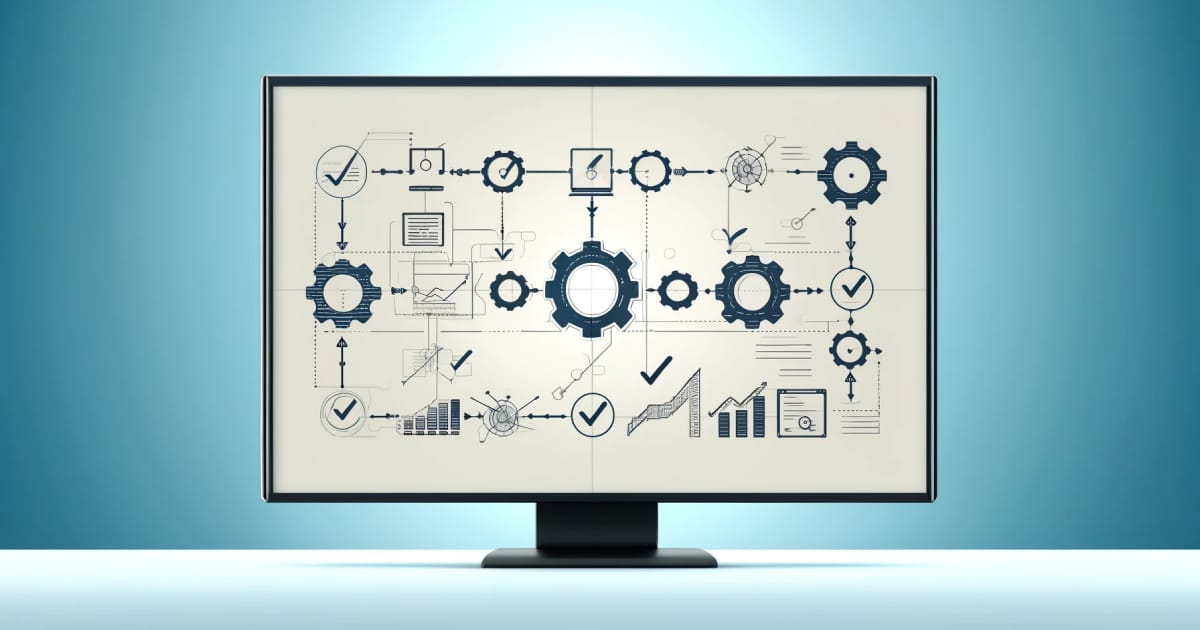5 Ways To Stop Being The Bottleneck In Your Business

Being efficient is very important, but one major thing that gets in the way of efficiency is bottlenecks. A bottleneck is anything that slows down or blocks the normal flow of work. It creates backups and holdups that hurt productivity and profits. Bottlenecks can happen anywhere in a business because of a specific person or process that can't keep up with the workload.
Spotting and fixing these bottlenecks is key to keeping operations running smoothly and efficiently. When a business leader becomes the bottleneck, it can seriously stall growth, slow down productivity, and frustrate employees. The good news is that by using the right strategies, leaders can stop being the bottleneck and build a more self-sufficient, effective team.
This article will cover 5 proven methods for leaders to avoid becoming a bottleneck: delegating better, optimizing processes, empowering employees, improving communication, and better time management. Putting these methods into practice can enhance operations, boost employee morale, and drive the business toward greater success.
Method 1: Delegation

Definition and Importance of Delegation
Delegation is the process of assigning responsibility and authority to others to complete tasks and make decisions. Effective delegation is essential for any business leader who wants to avoid becoming a bottleneck. It allows leaders to focus on higher-level strategic tasks while empowering employees to take ownership of their work.
Signs You Might Be Struggling with Delegation
- You are constantly overwhelmed with tasks.
- Deadlines are frequently missed because you handle too much yourself.
- Employees are disengaged or lack initiative.
- You find it difficult to trust others with important tasks.
Steps to Improve Delegation Skills
- Identifying Tasks to Delegate: Start by making a list of all the tasks you handle. Identify which tasks can be delegated to free up your time for more strategic activities.
- Choosing the Right Person for the Task: Match tasks with employees based on their skills, experience, and workload. Ensure the person selected is capable and has the potential to grow from the experience.
- Providing Clear Instructions and Resources: Clearly explain the task, its objectives, and the desired outcome. Provide the necessary resources and information to complete the task successfully.
- Setting Expectations and Deadlines: Communicate your expectations regarding quality and deadlines. Ensure that the employee understands the importance of the task and its impact on the business.
- Monitoring Progress Without Micromanaging: Check in regularly to monitor progress, offer support, and provide feedback. Avoid micromanaging, as it can undermine the trust and autonomy of your employees.
Case Studies or Examples of Successful Delegation
Consider a marketing manager who is overwhelmed with daily tasks, leaving little time for strategic planning. By delegating routine tasks like social media updates and email marketing to team members, the manager can focus on developing new marketing strategies, resulting in improved campaign effectiveness and team morale.
Another example is a CEO of a tech startup who delegates product development tasks to a competent CTO. This allows the CEO to focus on fundraising and business development, leading to faster growth and a more cohesive team.
Method 2: Process Optimization

Explanation of Process Optimization
Process optimization involves analyzing and improving business processes to make them more efficient and effective. Optimizing processes can eliminate bottlenecks, reduce waste, and improve overall productivity.
Common Signs of Inefficient Processes
- Frequent delays and missed deadlines
- High levels of waste or rework
- Employee frustration and low morale
- Inconsistent quality of output
Techniques for Process Optimization
- Mapping Out Current Processes: Create detailed flowcharts or diagrams of your current processes to understand each step and identify potential bottlenecks.
- Identifying Bottlenecks and Inefficiencies: Analyze the process maps to pinpoint where delays, waste, or inefficiencies occur. This can involve collecting data, observing workflows, and gathering employee feedback.
- Implementing Changes and Improvements: Develop and implement strategies to address the identified issues. This might include streamlining steps, eliminating redundant tasks, or reorganizing workflows.
- Utilizing Technology and Automation: Leverage technology to automate repetitive tasks and improve process efficiency. Tools like project management software, CRM systems, and automation platforms can significantly enhance productivity.
Case Studies or Examples of Optimized Processes
A retail company struggling with slow order fulfillment times maps out its order processing workflow and identifies bottlenecks in the picking and packing stages. By reorganizing the warehouse layout and implementing an automated inventory management system, the company reduces order fulfillment times by 30%, improving customer satisfaction and increasing sales.
Another example is a manufacturing firm facing high levels of waste and rework. By adopting Lean manufacturing principles and using Six Sigma techniques, the firm identifies inefficiencies and implements changes, resulting in a 20% reduction in waste and a 15% improvement in product quality.
Method 3: Empowering Employees

Definition and Importance of Employee Empowerment
Employee empowerment involves giving employees the authority, resources, and confidence to make decisions and take ownership of their work. Empowered employees are more engaged, motivated, and productive, which can help reduce bottlenecks caused by over-reliance on leadership for decision-making.
Ways to Empower Employees
- Providing Training and Development Opportunities: Invest in training programs and development opportunities to enhance employees' skills and knowledge. This not only improves their performance but also builds their confidence in handling more responsibilities.
- Encouraging Decision-Making and Accountability: Allow employees to make decisions related to their work and hold them accountable for the outcomes. This fosters a sense of ownership and encourages proactive problem-solving.
- Recognizing and Rewarding Contributions: Regularly acknowledge and reward employees for their contributions and achievements. This boosts morale and reinforces the value of their work.
- Creating a Supportive and Collaborative Culture: Foster a culture of support and collaboration where employees feel valued and encouraged to share ideas and feedback. This can lead to innovative solutions and a more cohesive team.
Case Studies or Examples of Empowered Employees Driving Success
A software development company implements a policy allowing developers to propose and lead their own projects. This results in increased innovation and faster development times as employees feel empowered to pursue their ideas.
In another instance, a hospitality business empowers its front-line staff to make decisions on guest requests without needing managerial approval. This leads to improved customer satisfaction and a more responsive service.
Method 4: Improving Communication

The Role of Communication in Preventing Bottlenecks
Effective communication is crucial for ensuring that information flows smoothly within an organization. Poor communication can lead to misunderstandings, delays, and frustration, creating bottlenecks that hinder productivity.
Signs of Poor Communication in Business
- Frequent misunderstandings and mistakes
- Lack of clarity in instructions and expectations
- Delays in project timelines due to miscommunication
- Low employee morale and engagement
Strategies to Improve Communication
- Implementing Regular Meetings and Check-Ins: Hold regular team meetings and one-on-one check-ins to ensure everyone is aligned, and any issues are addressed promptly.
- Using Effective Communication Tools: Leverage communication tools such as email, messaging apps, and project management software to facilitate clear and efficient communication.
- Encouraging Open and Honest Feedback: Create an environment where employees feel comfortable providing feedback and voicing concerns. This can help identify and address issues before they become major problems.
- Training on Communication Skills: Provide training on effective communication skills, including active listening, clear articulation, and constructive feedback. This can improve overall communication within the team.
Case Studies or Examples of Improved Communication Leading to Better Business Performance
A marketing agency facing project delays due to miscommunication between teams implements daily stand-up meetings and uses project management software to track tasks and deadlines. This improves coordination and reduces delays, resulting in more successful campaign deliveries.
Another example is a healthcare organization that trains its staff on effective communication techniques, leading to better patient care and higher patient satisfaction scores.
Method 5: Time Management

Importance of Time Management for Business Leaders
Effective time management is essential for business leaders to avoid becoming bottlenecks. Properly managing time allows leaders to prioritize high-impact activities, make better decisions, and maintain a healthy work-life balance.
Signs You Might Need to Improve Time Management
- Constantly feeling overwhelmed and stressed
- Missing deadlines or forgetting important tasks
- Spending too much time on low-priority activities
- Lack of time for strategic planning and development
Tips for Better Time Management
- Prioritizing Tasks and Focusing on High-Impact Activities: Identify high-impact tasks that align with your business goals and prioritize them. Use techniques like the Eisenhower Matrix to categorize tasks based on urgency and importance.
- Using Time Management Tools and Techniques: Utilize tools like calendars, to-do lists, and time-tracking apps to manage your schedule effectively. Techniques such as the Pomodoro Technique or time blocking can also help improve productivity.
- Setting Boundaries and Avoiding Multitasking: Set clear boundaries for work and personal time to prevent burnout. Avoid multitasking, as it can reduce productivity and increase stress. Focus on one task at a time to improve efficiency.
- Scheduling Regular Breaks and Downtime: Incorporate regular breaks and downtime into your schedule to recharge and maintain focus. This can help prevent burnout and improve overall productivity.
Case Studies or Examples of Effective Time Management
A busy entrepreneur struggling with time management starts using a time-tracking app to identify where their time is going. They then implement time blocking to focus on high-priority tasks, leading to increased productivity and better work-life balance.
In another case, a project manager uses the Pomodoro Technique to break work into focused intervals with short breaks. This approach improves concentration and reduces procrastination, resulting in more efficient project completion.
Final Thoughts
In the end, becoming a bottleneck in your business can really hold back progress and growth. But you can get rid of these bottlenecks and drive your business towards greater success by using effective strategies like delegating better, improving processes, empowering employees, communicating clearly, and managing your time well.
Putting these methods into practice takes commitment and ongoing effort, but the results are worth it. By creating a more efficient, empowered workplace with good communication, you'll improve your own productivity and help your whole team thrive.
Take the first step today - look at how you do things now and find areas to improve. Remember, the key to a successful business is being able to adapt, delegate, and empower others. With these strategies in place, you'll be on your way to removing bottlenecks and achieving your business goals.
Key Takeaways
| Method | Key Takeaways |
|---|---|
| 1. Delegation | - Identify and delegate tasks - Choose the right person - Give clear instructions - Set expectations and deadlines - Monitor progress effectively |
| 2. Process Optimization | - Map current processes - Identify inefficiencies - Implement improvements - Use technology and automation |
| 3. Empowering Employees | - Provide training - Encourage decision-making - Recognize contributions - Foster a supportive culture |
| 4. Improving Communication | - Hold regular meetings - Use communication tools - Encourage feedback - Train on communication skills |
| 5. Time Management | - Prioritize tasks - Use time management tools - Set boundaries - Schedule breaks |





